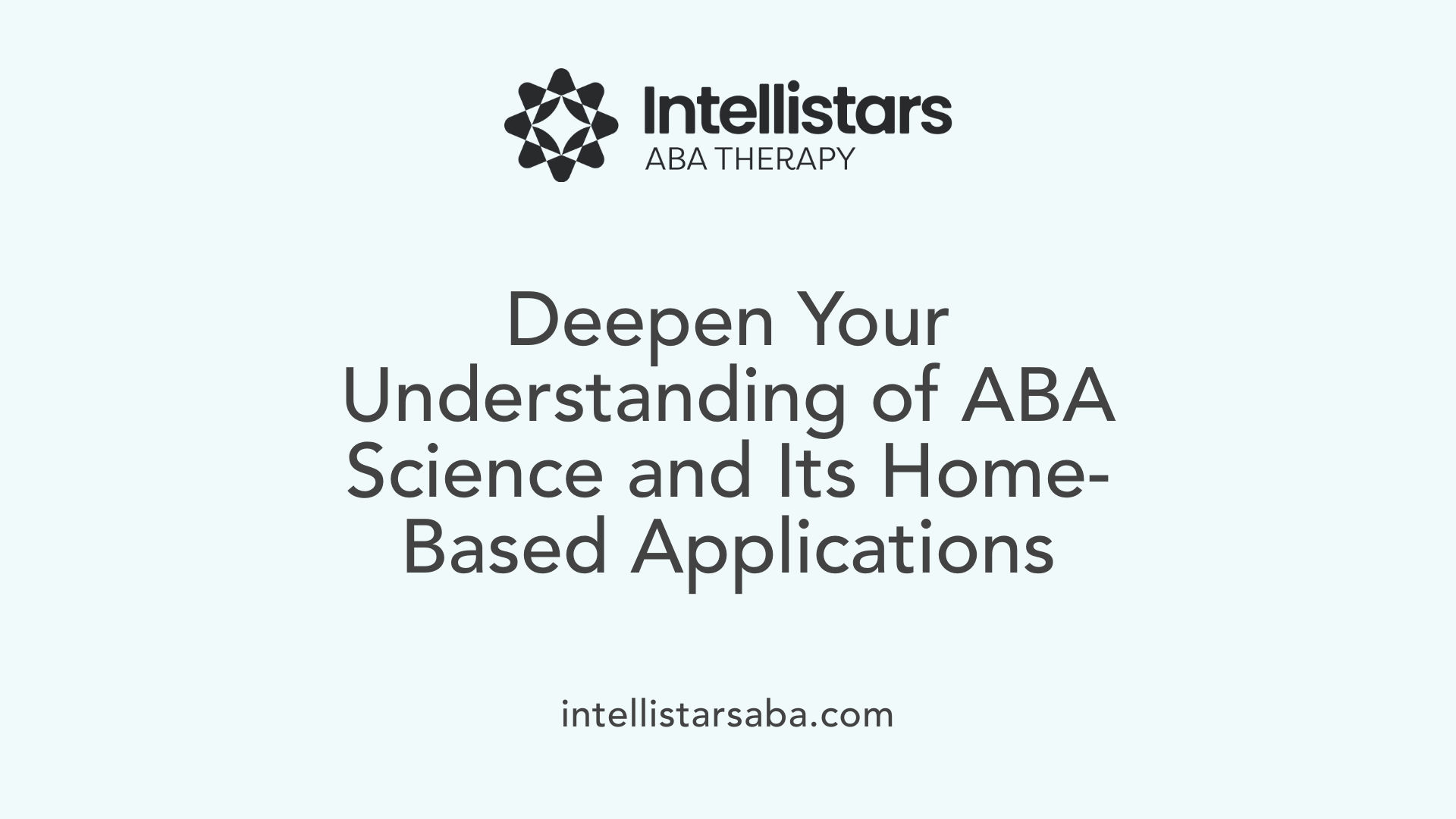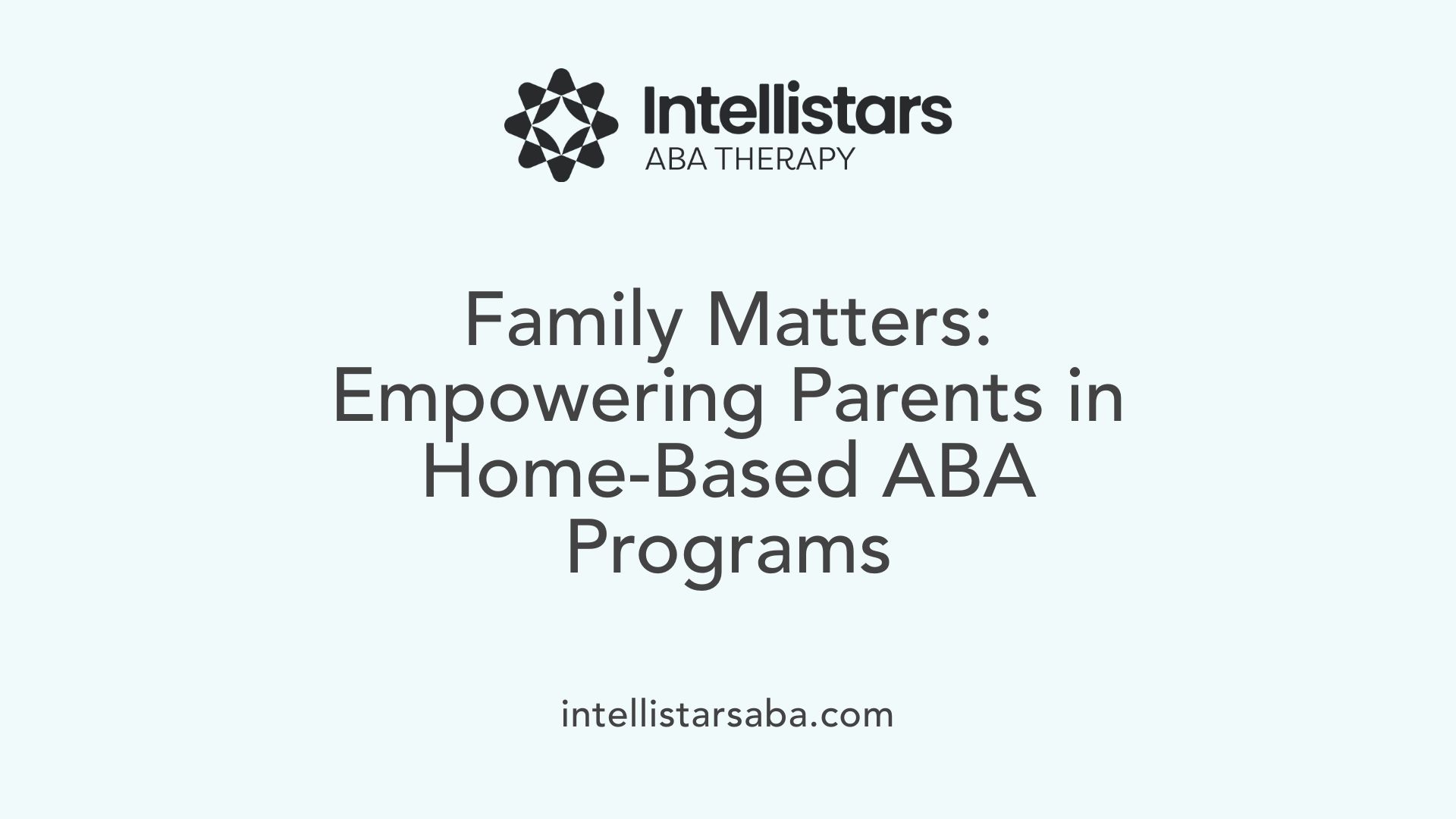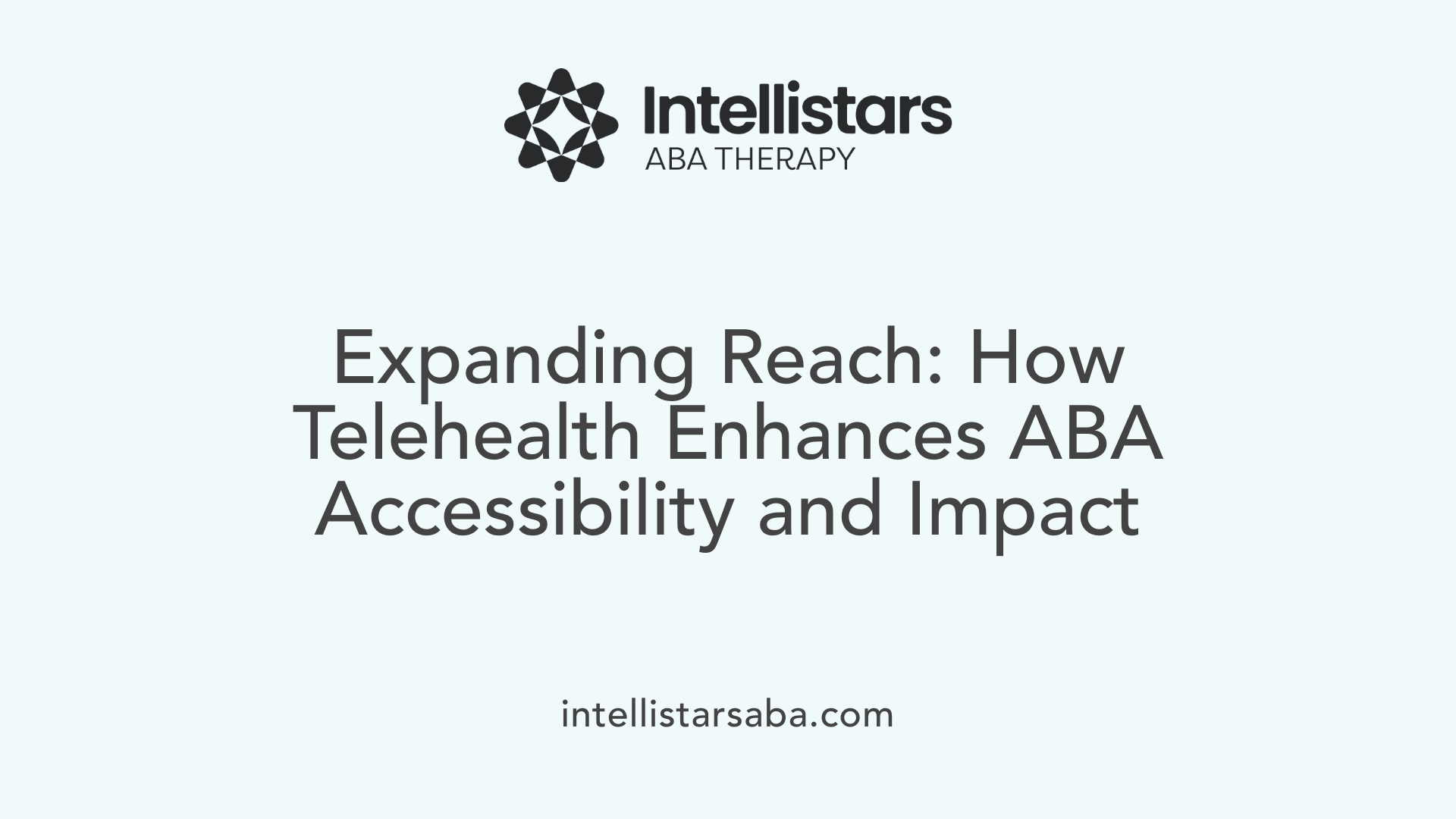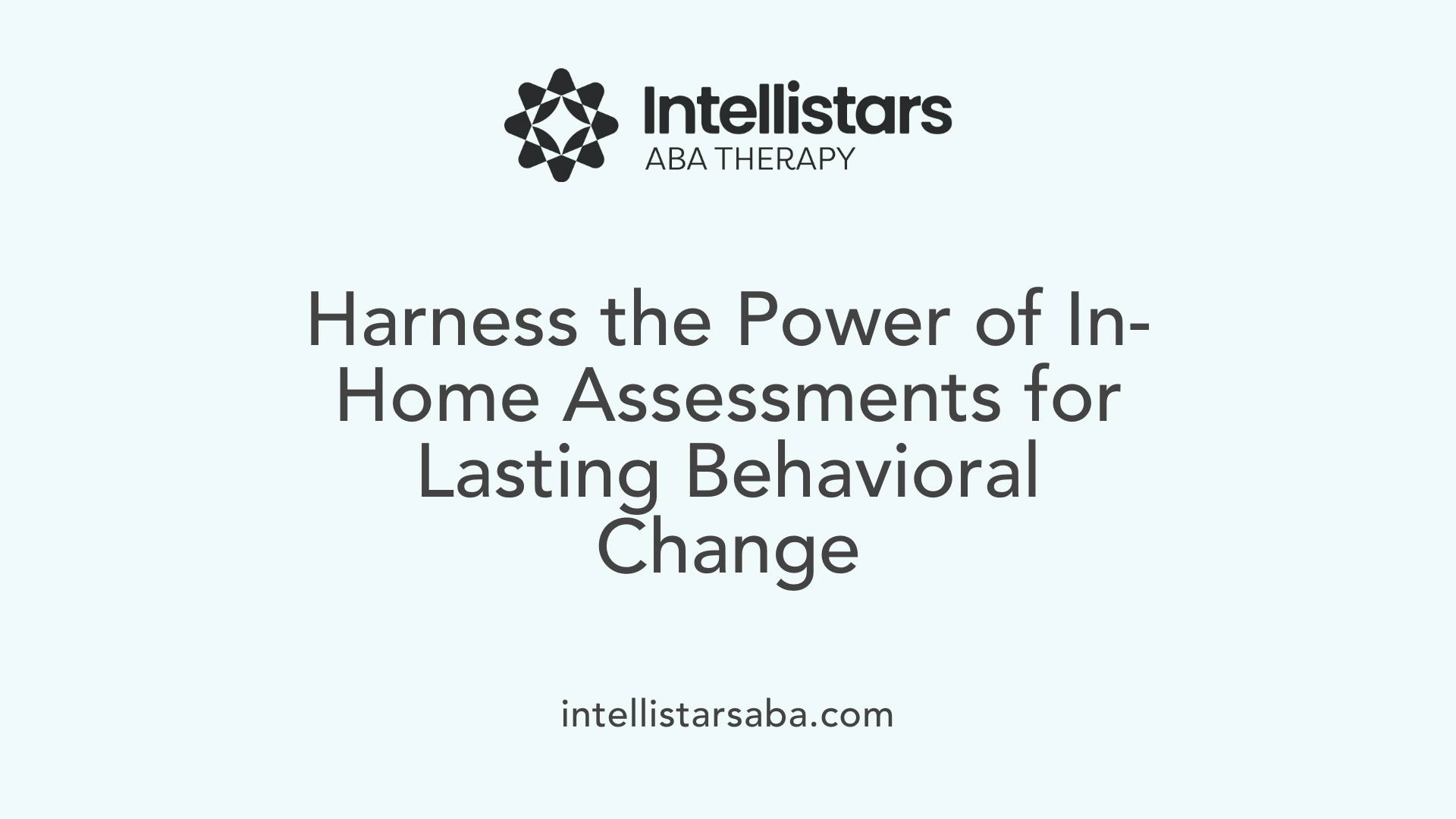Understanding the Impact of In-Home Evaluations in ABA Therapy
In-home assessments serve as a foundational component in customizing effective ABA therapy for children with autism. By integrating family involvement, observing behaviors in natural settings, and continuously monitoring progress, these evaluations ensure that interventions are tailored to the child's unique needs, resulting in more meaningful and sustainable outcomes.
The Science Behind ABA and Its Application in Home Settings

What are the basics of ABA science and techniques?
Applied Behavior Analysis (ABA) is rooted in the scientific study of learning and behavior. It involves understanding how behaviors are acquired, maintained, and changed by analyzing environmental factors. Key techniques include positive reinforcement—rewarding desirable behaviors to encourage their recurrence—and identifying antecedents and consequences that influence behavior, often summarized as the A-B-C model: Antecedent, Behavior, and Consequence.
ABA methods are highly adaptable, allowing interventions to be tailored to individual needs. These strategies are used across various settings, including homes, schools, and clinics, and can include visual aids, sensory coping techniques, and structured teaching approaches. Progress is meticulously tracked through data collection, ensuring that programs are regularly refined to meet evolving goals.
How does ABA help develop skills and reduce harmful behaviors?
ABA therapy aims to increase helpful behaviors such as communication, social skills, attention, and daily living tasks. At the same time, it works to decrease harmful or disruptive behaviors like aggression, self-injury, or tantrums. For example, children may learn to communicate their needs more effectively, which reduces frustration and associated problematic actions.
The success of ABA is supported by extensive research; over 20 studies confirm its effectiveness in improving outcomes for children with autism. Improvements are often evident as increased independence, better social interactions, and a reduction in behaviors that hinder learning or life quality.
How is ABA flexible and personalized?
One of the strengths of ABA is its flexibility. Interventions can be adapted to various settings and delivered by trained professionals such as Board Certified Behavior Analysts (BCBAs) and Registered Behavior Technicians (RBTs). Programs are personalized, grounded in assessment findings, and continuously adjusted based on ongoing data collection.
Whether in-home or in a center, ABA sessions are designed to meet specific developmental goals. For example, in-home programs enable practicing skills within daily routines, while center-based therapy offers a structured environment with access to a diverse team and peer interactions. This personalization ensures that each child’s unique skills, challenges, and preferences are central to their therapy plan.
How do in-home assessments improve the effectiveness of ABA therapy?
In-home assessments are a cornerstone of personalized ABA therapy. Conducted within the child's natural environment, they provide valuable insights into behaviors as they occur in daily routines. This setting helps therapists identify environmental influences and triggers that might not be apparent in clinical settings.
Assessments at home facilitate skill generalization, as children practice and demonstrate new behaviors within familiar contexts. They also promote stronger parent-therapist partnerships, as families are actively involved in observing and reinforcing strategies. Additionally, in-home assessments reduce child anxiety, allow flexible scheduling, and help detect environmental factors affecting behavior early on. Overall, this approach ensures a tailored, holistic, and effective treatment plan that maximizes developmental growth.
The Assessment Process at Home: Step-by-Step

What is the process involved in conducting in-home assessments for autism treatment?
Conducting an in-home assessment for autism relies on a structured, evidence-based process that can typically be completed remotely via virtual video appointments. This process usually involves three main steps.
First, families are asked to complete online questionnaires and participate in interviews with the healthcare provider. These questionnaires gather important information about the child's developmental history, medical background, and current behaviors. This information helps professionals understand the child's strengths and challenges.
Next, a behavioral observation is conducted in a quiet, familiar indoor environment. During this session, trained professionals use recommended toys and materials to observe the child's behaviors in real time. This observation allows for assessment of behaviors related to communication, social skills, and other developmental areas.
Finally, a results discussion takes place. The healthcare provider shares findings with the caregiver and discusses potential treatment options. This may include beginning ABA therapy, further assessments, or ongoing monitoring depending on the child's needs.
Through these steps, the assessment remains personalized, data-driven, and accessible. The entire process is designed to promote accuracy and comfort within the child's natural environment, making it easier for families to participate and engage in the child's developmental planning.
In summary, in-home autism assessments involve detailed questionnaires, behavioral observations with toys, and consultation discussions—all conducted remotely to ensure comprehensive understanding and tailored intervention strategies.
Monitoring Progress: How Home Evaluations Guide Treatment Effectiveness
How do in-home evaluations contribute to understanding progress and treatment success in ABA therapy?
In-home evaluations are essential tools in ABA therapy because they provide a window into a child's everyday environment. These assessments involve detailed observations and data collection that reflect the child's typical behaviors and responses in familiar settings, such as at home. This context allows therapists to accurately gauge how well interventions are working and whether behaviors are improving or needing adjustments.
Data collection methods like frequency counts (how often a behavior occurs), duration records (how long a behavior lasts), and interval recordings (behavior occurrence within specific time segments) are used during these evaluations. These metrics offer objective insights into the child's progress and are often summarized visually through charts and graphs. Visual representations help identify patterns, trends, and fluctuations over time which might not be obvious through anecdotal observations alone.
In addition to these formal data, feedback from parents and caregivers plays a crucial role. Their daily interactions with the child provide anecdotal evidence and contextual information that helps interpret the data more comprehensively. This feedback may include observations about the child's response to routines, social interactions, or new skills learned.
Regular in-home evaluations also ensure that the therapy remains aligned with the child's evolving developmental needs. When progress is monitored continuously, therapists can identify when interventions need to be intensified, modified, or introduced. Adjustments may include implementing new strategies, focusing on different skills, or modifying reinforcement techniques to keep the child motivated.
Overall, in-home evaluations foster a well-rounded understanding of a child's progress. They offer real-time, contextual data paired with parental insights, enabling therapy to be tailored precisely. This ongoing, personalized monitoring supports meaningful improvements in skills and behaviors, leading to better long-term outcomes.
The Significance of Family Involvement in Home-Based ABA

Why are in-home assessments important for remote or home-based ABA therapy?
In-home assessments play a vital role in the success of remote or home-based ABA therapy. These evaluations are conducted within the child's natural environment, allowing therapists to observe genuine behaviors and interactions as they occur in daily routines.
By assessing children at home, therapists can identify environmental factors and routines that influence behavior. This insight helps them develop more personalized and effective intervention strategies tailored to the child's specific context.
Family members actively participating in assessments provide invaluable information about the child's strengths, challenges, and history. This collaboration fosters a deeper understanding of the child's needs and promotes a sense of partnership.
Furthermore, observing the child in their home allows for the detection of how different settings and stimuli impact behavior, aiding in designing interventions that promote skill generalization across various environments.
Overall, in-home assessments ensure that therapy is relevant, practical, and directly applicable to the child's everyday life. They empower families by involving them in the evaluation process and laying the groundwork for targeted, effective treatment plans.
Benefits of In-Home ABA Over Center-Based Settings
How do in-home assessments improve the effectiveness of ABA therapy?
In-home assessments greatly enhance the effectiveness of ABA therapy by taking place in the child's natural environment. This setting allows therapists to observe behaviors as they occur during everyday routines, providing genuine insights into the child's current skills and challenges. Such real-world observations help tailor interventions more precisely to the child's needs.
Performing assessments at home encourages the generalization of skills. Children practice learned behaviors in familiar contexts, increasing the likelihood that these skills will transfer to other settings and situations. This continuity supports more stable and enduring progress.
Family engagement and empowerment are pivotal advantages of in-home therapy. Parents and siblings are actively involved, allowing them to understand and reinforce strategies beyond formal sessions. This consistent reinforcement significantly boosts the child's learning and confidence.
Moreover, home-based assessments can identify environmental factors that impact behavior. Recognizing these factors early helps develop more comprehensive and effective intervention plans. It also reduces the child's anxiety, as familiar surroundings help them feel more comfortable and open.
Flexibility in scheduling is another benefit. Therapies can be arranged around family routines, ensuring less disruption and more consistent participation. Overall, in-home assessments foster a personalized, holistic approach that maximizes developmental outcomes, making ABA therapy more responsive and effective.
The Role of Telehealth in Increasing Accessibility and Effectiveness

What are the benefits of delivering ABA services remotely?
Telehealth has revolutionized Access Behavioral Analysis (ABA) by making therapy sessions available in virtual formats. This approach breaks down geographical barriers, allowing children and families in rural, underserved, or remote areas to access high-quality ABA services that might otherwise be unavailable. Remote delivery enables therapists to provide real-time coaching, guidance, and interventions directly in the child's natural environment. It also supports continuity of care, especially during circumstances like public health crises, when in-person visits may be limited.
Moreover, telehealth fosters greater parental involvement, as caregivers can participate actively during sessions, applying techniques immediately under therapist supervision. This interactive format enriches the therapy, making it more personalized and effective.
How does telehealth improve cost-effectiveness and convenience?
One of the most notable advantages of telehealth is its potential to reduce costs associated with travel and logistics. Families save time and money by avoiding long commutes to clinics or centers.
Additionally, flexible scheduling options mean sessions can be tailored around family routines, work commitments, and other responsibilities. Parents no longer need to take extensive time off work or manage transportation; instead, they can host sessions from the comfort of their home or preferred safe environment.
This convenience often leads to increased session attendance and consistency, which are crucial for positive outcomes in ABA therapy.
How does parental involvement through coaching and instruction enhance remote ABA?
Remote ABA greatly emphasizes active parental involvement through coaching and real-time instruction. During telehealth sessions, therapists work directly with parents and caregivers, guiding them on how to implement behavioral strategies.
This hands-on coaching helps caregivers feel more confident and competent in applying techniques consistently, leading to better generalization of skills outside therapy sessions.
Engaged parents receive instant feedback, learn to identify antecedents and consequences of behaviors, and can effectively manage daily routines. This collaborative effort results in more personalized intervention plans and accelerates progress.
Why are in-home assessments important for remote or home-based ABA therapy?
In-home assessments are vital for optimizing remote or home-based ABA therapy because they provide valuable insights into the child's natural behaviors, routines, and environment. Conducting assessments within the home enables therapists to observe how behaviors manifest in daily life, identify environmental triggers, and understand the child's interactions with family members.
This information allows for tailored intervention strategies that are directly applicable to the child's real-world context. It also encourages active family participation, ensuring that caregivers are equipped with practical tools and techniques.
Moreover, in-home assessments facilitate the observation of the child's generalization of skills across various settings, promoting more effective and sustainable progress. This approach underscores the importance of grounding remote therapy services in the child's everyday environment, increasing their relevance and success.
Data-Driven Goals and Long-Term Outcomes in ABA
How do in-home evaluations contribute to understanding progress and treatment success in ABA therapy?
In-home evaluations are a crucial component of effective ABA therapy because they provide real-world insight into a child’s development within their everyday environment. These assessments enable therapists to observe the child's behaviors as they naturally occur, rather than in a clinical setting.
During in-home evaluations, therapists collect detailed data on behaviors, such as how often specific actions happen and how long they last. Techniques like frequency counts, duration recordings, and interval methods are used to gather accurate information. This data can be visually analyzed using charts and graphs, revealing patterns and trends over time that might not be evident through observation alone.
Parents and caregivers also play a vital role by sharing their observations and providing feedback. This collaboration enriches the assessment process, ensuring it captures a comprehensive picture of the child's skills and behaviors. Alongside formal tools like VB-MAPP and ABLLS-R, these insights allow for a tailored approach to therapy.
Regular in-home evaluations help therapists monitor whether strategies are effective and if goals are being met. They also allow for timely modifications to interventions, ensuring the program remains aligned with the child's evolving needs. Ultimately, these assessments foster a thorough understanding of a child's progress, leading to more personalized and successful treatment outcomes.
Use of charts and graphs for analysis
Data collected from evaluations is often translated into charts and graphs, making it easier to interpret progress visually. Line graphs may show improvements in social interactions over several months, while bar charts can compare baseline and current levels of communication skills. These visual tools help therapists and families see at a glance whether the child is moving toward targeted goals.
Tracking skills and behavioral changes over time
Continuous tracking of skills, such as language abilities, social skills, and daily living tasks, demonstrates growth and identifies areas needing additional focus. A decline in problematic behaviors like tantrums or aggression also indicates positive change. Over time, this data helps confirm when skills have been mastered and when behaviors have reduced to manageable levels.
Additionally, consistent documentation ensures progress is sustained post-intervention, signifying long-term success. Regular review and analysis of these data points are essential for maintaining effective therapy and achieving meaningful, lasting results.
Integrating Continuous Assessment for Better Outcomes
How do in-home evaluations contribute to understanding progress and treatment success in ABA therapy?
In-home evaluations are a crucial element of effective ABA therapy because they provide a window into how a child behaves in their natural environment. Unlike clinics, a home setting reflects the child's typical routines, interactions, and challenges, offering a realistic picture of their skills and behaviors.
During these evaluations, therapists observe and record behaviors using various methods such as frequency counts, duration recordings, and interval assessments. These data are then visually represented in charts and graphs, making it easier to spot patterns and track changes over time.
Parents and caregivers also play a vital role by sharing anecdotal information from everyday life. Their insights help therapists understand context-specific behaviors and refine intervention plans accordingly.
Regular in-home assessments help ensure that therapy goals adapt as the child develops. If progress slows or challenges arise, these evaluations allow for timely adjustments to strategies, making therapy more personalized and effective.
By combining direct observation, data collection, and parental feedback, in-home evaluations support a comprehensive view of a child's achievements. This approach promotes targeted interventions, improves skill acquisition, and maximizes therapy outcomes.
The Role of Routine Data Collection in ABA
Consistent data collection underpins successful ABA programs. Therapists gather detailed information on behaviors, skill development, and response to interventions during each session. This process helps establish clear benchmarks for progress.
The data collected is analyzed meticulously to evaluate what strategies are effective. When data indicates stagnation or regression, therapists can modify their approach or introduce new methods. Routine data collection ensures that interventions remain dynamic and responsive to the child's needs.
Regular Progress Reviews for Better Outcomes
Scheduled reviews of gathered data allow therapists, parents, and caregivers to collaboratively assess progress. These reviews help identify areas where the child is excelling and pinpoint aspects that need additional focus.
Adjustments based on this data can include changing reinforcement systems, introducing novel activities, or modifying communication strategies. Regular reviews foster transparency and shared responsibility among team members, which enhances motivation and adherence.
Table Summarizing the Data-Driven Approach in ABA
| Aspect | Description | Examples |
|---|---|---|
| Routine Data Collection | Continuous recording of behaviors and skills | Frequency counts of tantrums, duration of focus sessions |
| Progress Reviews | Analyzing data to evaluate development | Monthly data review meetings, evaluating skill acquisition charts |
| Program Adjustments | Modifying interventions based on data insights | Changing reinforcement schedules, introducing visual aids |
| Outcomes Tracked | Measuring improvements over time | Increased independence, decreased problem behaviors |
This structured approach ensures therapy remains effective and goal-oriented, leading to better long-term results.
Conclusion: Maximizing Outcomes with In-Home Assessments

What are the benefits of in-home assessments in ABA therapy?
In-home assessments provide a comprehensive understanding of a child's behavior in their everyday environment. This setting allows therapists to observe how behaviors occur naturally during daily routines, which is crucial for designing effective, personalized interventions. Such assessments help identify specific environmental factors, routines, and interactions that influence behavior, enabling tailored strategies that are directly applicable to the child's real-life context.
Moreover, in-home assessments actively involve family members, creating a partnership that enhances the therapy’s relevance and sustainability. Families learn how to implement techniques effectively, which promotes consistent progress and skill generalization across different settings.
These assessments also allow for real-time observation of how a child interacts with family members and navigates familiar routines. This information is invaluable for crafting practical and impactful treatment plans that reflect the child's typical environment.
How do in-home assessments support a holistic approach to treatment?
In-home assessments contribute to a comprehensive view of a child's development, behaviors, and environmental influences. This approach considers not only the child's skills and challenges but also their home routines, sensory sensitivities, and social interactions.
Understanding these elements enables therapists to develop strategies that address the child's unique needs holistically. For example, visual aids or sensory coping techniques can be integrated based on observed preferences, helping the child adapt better and achieve more meaningful progress.
The personalized nature of in-home assessments ensures that intervention goals are realistic, relevant, and aligned with the child's daily life, leading to more effective and sustainable outcomes.
What role does family involvement and progress tracking play in in-home ABA assessments?
Family involvement is essential in maximizing therapy effectiveness. In-home assessments foster strong partnerships between families and therapists by encouraging open communication and active participation.
Families are engaged through questionnaires, interviews, and observations, which help gather detailed developmental and behavioral data. This collaboration ensures that intervention plans are aligned with the family's routines and values, increasing adherence and success.
Furthermore, regular progress tracking through ongoing data collection allows therapists to monitor whether goals are being met. Adjustments can be made promptly if progress stalls, ensuring continuous improvement.
Living environments provide opportunities for real-time coaching, enabling families to directly apply strategies and witness improvements firsthand. This active role in therapy enhances confidence, knowledge, and skills, ultimately leading to better long-term outcomes.
| Aspect | Benefits | Additional Notes |
|---|---|---|
| Setting of Assessment | Natural environment | Offers realistic behavior observation |
| Family Role | Active participation | Facilitates tailored and consistent support |
| Progress Monitoring | Data collection | Ensures adaptive and effective interventions |
| Intervention Application | On-the-spot coaching | Reinforces skills and builds confidence |
Through holistic, family-centered, and data-driven approaches, in-home assessments significantly improve the effectiveness and relevance of ABA therapy, creating a strong foundation for lasting development and skill acquisition.
Harnessing In-Home Assessments for Better Autism Outcomes
In-home assessments play a pivotal role in optimizing ABA therapy by offering personalized, environment-specific insights that foster skill generalization and family engagement. Through systematic data collection, real-time observations, and collaborative goal-setting, these evaluations significantly improve the precision and effectiveness of interventions. As ABA continues to evolve with remote and hybrid models, in-home assessments remain a cornerstone in ensuring children with autism receive tailored, accessible, and impactful care that promotes their independence, social integration, and overall quality of life.
References
- Applied Behavior Analysis (ABA) | Autism Speaks
- The Crucial Role of Parent Assessments in ABA Therapy
- ABA Therapy In-Home vs At a Center: 5 Key Differences
- Telehealth in ABA Therapy: Benefits, Challenges, and Best Practices
- How to Tell If ABA Therapy Treatment Is Working
- In-Home ABA Therapy for Autism
- Can ABA Be Done Remotely? Exploring Telehealth ABA Therapy
- Complementing Center-Based ABA Interventions with In-Home Care
- Understanding Remote Autism Assessments: Our Guide
- Telehealth in ABA Therapy: Benefits, Challenges, and Best Practices






